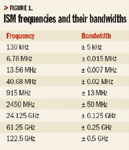Why Use 134 kHz?
From what I've read, wireless sensors and other wireless devices work at ISM frequency bands of 900 MHz and 2.4 GHz. But I've read, too, about "ISM-compliant" RFID tags and readers that work at 134 kHz.
Is 134 kHz an ISM band? Are there other ISM frequencies? And why would a company have something working at 134 kHz when they could use the 900 MHz band?
Signed, Ever-Compliant
Wise Guy: While most ISM discussion covers the 900 MHz and 2.4 GHz ranges, a number of other ISM bands exist. Figure 1 lists them. RFID tags and readers, like other wireless gizmos, may operate in any of these bands.
 Figure 1. ISM frequencies and their bandwidths |
In the U.S., two RFID frequencies are used: 125 kHz (the original standard) and 134.2 kHz (the international standard). The reason a company would choose 134 kHz involves application specifics. Without knowing the type of application your example system targets, I can't directly answer your "why use 134 kHz?" query. But signals in this range penetrate water, tissue, and wood quite well—which is why some RFID companies use it. Thus, systems using this frequency are in use for tracking animals (to control mad cow disease, find lost pets, etc.)—and people. But do be aware that the low operating frequency also implies low data rate applications.
More on Personal Safety
Last month I wrote asking whether I should be concerned for my personal safety with all the wireless signals out there. You answered that signals in the industrial, scientific, and medical (ISM) bands will not cause damage to the cells in the human body.
But I'm not yet ready to change my initials to I.M. I know that my WiFi base station—like my microwave oven—works at 2.4 GHz. Don't its signals—and those little wireless sensor nodes—heat me up?
Signed, M.I. Safe
Wise Guy: Notwithstanding the fact that you might get "heated up" by content delivered across your WiFi channel, the water molecules inside you may indeed absorb some of that signal. But let's look closer.
Water absorbs energy in a very narrow frequency band (100 kHz), centered at ~2450 MHz. In the 2.4 GHz ISM band, WiFi channel slots are 20 MHz and organized in groups of three with "frequency reuse" (a fancy term for overlap) between them. So, for example, channel 1 overlaps some with channel 2 and a bit with channel 3; 4, 5, and 6 have similar overlap characteristics; same for 7, 8, and 9; and for 10, 11, and 12. In addition, video surveillance cameras, devices conforming to the IEEE 802.15.4 standard (upon which ZigBee is built), and other wireless instruments also operate in this range. The net result is potential for a lot of signals propagating in the same physical environment within this band.
The amount of the transmitted signal within the 100 KHz absorption band is q = (0.1 MHz/20 MHz), or 0.5% of the transmitted intensity of 1 W (that is, 5 mW). Assuming that a WiFi transmitter is radiating at 1 W, and that you have not wrapped yourself around the WiFi base station (if you have I recommend a psych assessment!), your absorption cross section is substantially <360°.
Compare that to a conventional microwave oven, which emits approximately 700 W.
The bottom line is this: Studies have shown that RF energy routinely encountered by the general public is typically far below levels necessary to produce significant heating and increased body temperature. Energy in workplace environments near high-powered RF sources, however, could exceed recommended limits for safe exposure. If you'd like more detailed information on this topic, you can get it at www.fcc.gov/oet/rfsafety.
Wise Guy is the problem-solving persona of WINA, the Wireless Industrial Networking Alliance ( www.wina.org). Send your questions to [email protected].